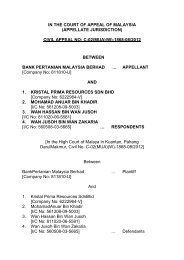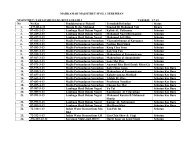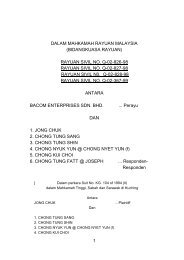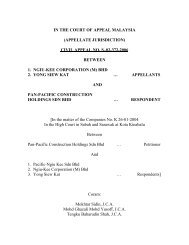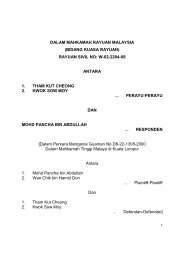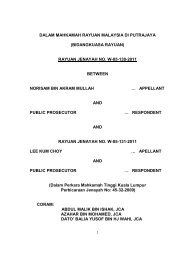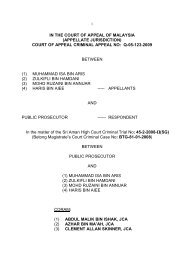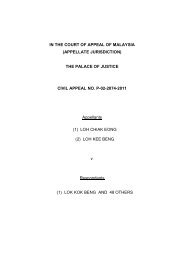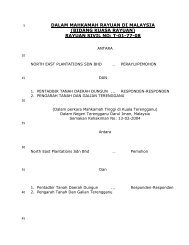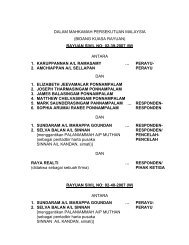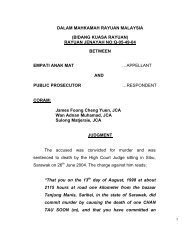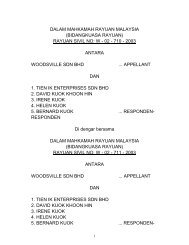rayuan jenayah no. b-05-18-2009 antara faisal bin abd. aziz
rayuan jenayah no. b-05-18-2009 antara faisal bin abd. aziz
rayuan jenayah no. b-05-18-2009 antara faisal bin abd. aziz
You also want an ePaper? Increase the reach of your titles
YUMPU automatically turns print PDFs into web optimized ePapers that Google loves.
DALAM MAHKAMAH RAYUAN MALAYSIA<br />
(BIDANG KUASA RAYUAN)<br />
RAYUAN JENAYAH NO. B-<strong>05</strong>-<strong>18</strong>-<strong>2009</strong><br />
ANTARA<br />
FAISAL BIN ABD. AZIZ … PERAYU<br />
DAN<br />
PENDAKWA RAYA … RESPONDEN<br />
(Dalam Mahkamah Tinggi Di Shah Alam<br />
CORAM:<br />
HASAN LAH, JCA<br />
ABDUL MALIK BIN ISHAK, JCA<br />
MOHAMED APANDI BIN ALI, JCA<br />
Perbicaraan Jenayah No. 45-83-2006<br />
Antara<br />
Faisal <strong>bin</strong> Abd. Aziz<br />
Dan<br />
Pendakwa Raya)<br />
1
GROUNDS OF JUDGMENT<br />
The Appellant has been convicted for an offence under<br />
Section 39B(1)(a) of the Dangerous Drugs Act 1952 and<br />
sentenced to death under Section 39B(2) of the Act. The charge<br />
against the Appellant reads as follows:-<br />
“Bahawa kamu pada 23 Januari 2006, jam lebih kurang 5.30<br />
petang, di kawasan kelapa sawit Cyberjaya Dengkel, di dalam<br />
Daerah Sepang di dalam Negeri Selangor Darul Ehsan, telah<br />
memperedarkan dadah berbahaya jenis Cannabis seberat 406.93<br />
gram, oleh yang demikian kamu telah melakukan suatu kesalahan<br />
di bawah Seksyen 39B(1)(a) Akta Dadah Berbahaya 1952 dan<br />
boleh dihukum di bawah Seksyen 39B(2) Akta yang sama.”.<br />
Factual Background<br />
As per the opening speech by the prosecution, the case for the<br />
prosecution commenced with the usage of an agent provocateur in<br />
the form of a police personnel, L/Cpl. Mohd. Hafiz <strong>bin</strong> Zainuddin<br />
(SP2). The facts of the case can be briefly narrated as follows:-<br />
(a) On 23 rd January 2006 at about 1 pm, SP2, L/Cpl. Mohd.<br />
Hafiz acting on information received and upon receiving a<br />
contact number from a source, contacted the Appellant<br />
via his hand-phone. SP2 contacted the Appellant via the<br />
said given number, which was 019-6324234.<br />
Masquerading as a potential buyer, SP2 enquired to<br />
purchase Cannabis worth RM100.00. The man at the<br />
2
end of the line responded positively and an arrangement<br />
was made for the purchase to be done later in the late<br />
after<strong>no</strong>on on the same day, i.e. on 23 rd January 2006.<br />
(b) SP2 then informed his superior, Insp. Syed Nadzely <strong>bin</strong><br />
Syed Jaafar (SP3) of the arrangement for the purchase of<br />
the drugs. SP3 then mobilized an ambush party<br />
comprising SP2 and seven other police personnels. At<br />
5.<strong>05</strong> pm SP2 made a second call to the hand-phone<br />
number 019-6324234 and the person who answered the<br />
call sounded like the one who responded to the earlier<br />
call. The person informed that he was within the vicinity<br />
of an oil palm estate, near University Lim Kok Wing in<br />
Cyberjaya. The police party, led by SP3 then proceeded<br />
to the said oil palm estate.<br />
(c) Before going into the estate, SP2 made a 3 rd call to the<br />
same hand-phone number, to inform that he has arrived.<br />
The answerer directed SP2 to walk into the estate. The<br />
time was about 5.30 pm. SP2 and SP3 walked into the<br />
estate and the rest of the police party hid in the bushes<br />
within the said estate. SP2 walked infront, followed by<br />
SP3. SP2 then made a<strong>no</strong>ther call to the same number<br />
and by then SP2 saw the Appellant using his hand-phone<br />
and waved to SP2, beckoning SP2 to walk towards him.<br />
(d) Upon coming face to face with the Appellant, SP2 told the<br />
Appellant of the intended purchase of RM100.00 worth of<br />
3
ganja (Cannabis). The Appellant then went to some<br />
bushes nearby and took out something from the bushes<br />
and handed 2 transparent plastic packages suspected to<br />
contain Cannabis to SP2. SP2 took the 2 transparent<br />
plastic packages that was handed over by the Appellant<br />
and passed the 2 packages to SP3. At that very moment<br />
SP2 identified himself as police and arrested the<br />
Appellant. There was a brief struggle but with help of<br />
SP2, the Appellant was subdued and handcuffed. A body<br />
search was done on the Appellant but <strong>no</strong>thing<br />
incriminating was found on his body. The Appellant was<br />
hand-cuffed with his hands at the back.<br />
(e) SP3 then proceeded to administer the caution under<br />
Section 37A(1)(b) of the Dangerous Drugs Act 1952 to<br />
the Appellant before questioning the Appellant of the<br />
whereabout of any other drugs. The Appellant pointed to<br />
the bushes, about 2 meters away from where he was<br />
arrested. The Appellant showed a bag in the bushes, and<br />
with his hand-cuffed hands, he took the bag and handed it<br />
to SP3. SP3 took the bag and upon examination found it<br />
to contain several packages containing ganja (Cannabis).<br />
(f) The Appellant, together with the bag containing several<br />
packages of ganja and his hand-phone (P16) were then<br />
taken to the Narcotic Office in IPD Sepang. The drugs<br />
recovered were as follows:-<br />
4
(i) 2 small packages containing Cannabis,<br />
produced and marked as exhibits P8A and<br />
P8B.<br />
(ii) A small “old spice” bag (exhibit P9)<br />
containing:-<br />
(1) A plastic package containing a<br />
5<br />
compressed slab of Cannabis<br />
(produced and marked as exhibit<br />
P10A).<br />
(iii) 80 small plastic packages containing<br />
Cannabis, produced and marked as exhibit<br />
P12(1) to P12(80).<br />
(iv) 44 small plastic packages containing<br />
Cannabis, produced and marked as exhibit<br />
P13(1) to P13(44).<br />
A Search List of the recovered items was issued and<br />
ack<strong>no</strong>wledged by the Appellant. The Search List was<br />
marked as exhibit P17.<br />
(g) The Appellant and the exhibits were then handed to the<br />
Investigating Officer, C/Insp. Saidon <strong>bin</strong> Halid, SP4. SP4<br />
doubled-up as a police photographer and took<br />
photographs of the exhibits at the scene of the offence.<br />
The photographs were produced and marked as exhibit<br />
P14 A-C. The exhibits recovered were later then sent to
the Chemist, Abdul Rahim <strong>bin</strong> Shadan, SP1. On<br />
analysis, SP1 found the exhibits to contain Cannabis, of<br />
which the break-down figures are as follows:-<br />
(i) In P8A and P8B : 14.93 grams of Cannabis<br />
(ii) In P12(1) - P12(80) : 26.74 grams of Cannabis<br />
(iii) In P13(1) - P13(44) : 232.2 grams of Cannabis<br />
(iv) In P10A : 133.06 grams of Cannabis<br />
Total net weight : 406.93 grams of Cannabis<br />
SP1 prepared a Chemist Report that was produced and<br />
marked as exhibit P6.<br />
Findings by the High Court:<br />
At the end of case for the prosecution, the learned trial Judge<br />
ruled that there was a prima facie case against the Appellant for the<br />
offence of trafficking in dangerous drugs under Section 39B(1)(a) of<br />
the Dangerous Drugs Act; and accordingly called for the defence.<br />
The Appellant elected to give evidence on oath. The learned<br />
trial Judge, at the end of the trial, having evaluated all the evidence<br />
adduced at the trial, concluded, inter alia, that the defence are just<br />
bare denials. The Judge then made a finding that the defence failed<br />
to raise any reasonable doubt and corollary to that found that the<br />
prosecution had proved its case beyond reasonable doubt and<br />
accordingly convicted and sentenced the Appellant.<br />
6
Submissions by the Appellant<br />
Learned Counsel for the Appellant in his oral and written<br />
submissions, argued on three main issues:<br />
(1) Issue of possession; where it was submitted that there<br />
was <strong>no</strong> affirmative finding on this issue.<br />
(2) Issue of trafficking: It was submitted that there is <strong>no</strong><br />
trafficking as defined under Section 2 of the Dangerous<br />
Drugs Act. It was further submitted that if at all, the<br />
Appellant was in possession of the drugs in exhibits P8A<br />
and P8B and such possession was only “passive<br />
possession”. In support of the argument, learned<br />
Counsel relied on the cases of PP v Haling Arala<br />
Jimjani [2008] 4 CLJ 163 and Arumugam Periasamy v<br />
PP [20<strong>05</strong>] 3 CLJ 685.<br />
(3) Issue of information leading to discovery under Section<br />
27 of the Evidence Act 1950. It was submitted that the<br />
act of pointing to the bushes by the Appellant is <strong>no</strong>t<br />
sufficient to qualify as information under Section 27. On<br />
this argument, learned Counsel cited the case of Roslan<br />
Abdullah v PP [2010] 1 CLJ 685.<br />
Our findings And Conclusion<br />
As the Appellate Court, our task is to peruse the Record of<br />
Appeal and upon hearing submissions by both parties we have to<br />
7
evaluate whether the trial Judge has erred in his findings and<br />
conclusion on the issues raised by the Appellant. We shall deal with<br />
the respective issues accordingly.<br />
(a) On the issue of possession, we <strong>no</strong>te that there is <strong>no</strong> issue<br />
in respect of the first 14.93 grams of Cannabis contained<br />
in the two small packages marked as exhibits P8A and<br />
P8B. These two packages were the ones that were<br />
handed over to SP2 by the Appellant, prior to his arrest.<br />
The main bone of contention is in respect of the rest of<br />
packages of Cannabis found in the ‘old spice’ bag (P9).<br />
From the evidence adduced, the factual matrix as to<br />
how P9 was recovered can be seen in the evidence of<br />
SP2, who narrated that:<br />
“OKT bawa saya dan Insp. Syed di semak<br />
berhampiran dan tunjukkan satu beg yang tersorok di<br />
kawasan semak.<br />
Tempat OKT ditangkap dan beg disorok lebih kurang<br />
2 meter.<br />
Dengan kedua-dua tangan digari di belakang OKT<br />
mengambil beg tersebut dan serahkan kepada Insp.<br />
Syed,<br />
Insp. Syed membuka beg tersebut dan membuat<br />
pemeriksaan.<br />
Saya nampak beberapa paket plastik lutsinar yang<br />
disyaki berisi ganja – banyak paket-paket kecil.”.<br />
8
This evidence was corroborated by SP3 who said:-<br />
“Lanjutan dari OKT menunjukkan tempat dadah yang<br />
disorok – tidak jauh dari tempat tangkapan.<br />
OKT tunjukkan 1 beg warna biru disorokkan dalam<br />
semak.<br />
OKT ambil beg tersebut dalam keadaan tangannya<br />
digari di belakang dan serahkan kepada saya.<br />
Saya membuka zip beg dan dapati paket lutsinar<br />
berisi tumbuhan kering dalamnya.<br />
Saya tutup zip beg dan bawa OKT dan barang kes<br />
menuju ke jalan besar.”.<br />
The oral evidence of SP2 and SP3 was further<br />
corroborated by the Search List that was issued by SP3<br />
and ack<strong>no</strong>wledged by the Appellant, on the date of the<br />
alleged offence. The Search List was produced and<br />
marked as exhibit P17. It is <strong>no</strong>ted that there was <strong>no</strong><br />
cross-examination on this exhibit.<br />
A quick look at the grounds of Judgment, will<br />
indicate that the trial Judge had in fact made an<br />
affirmative finding of possession of the drugs by the<br />
Appellant. In his Judgment, the Judge (at page 55 of the<br />
Record of Appeal) wrote:-<br />
“It is also pertinent to stress that the manner of<br />
the packaging in small packets and the circumstances<br />
9
elating to the accused conduct of handing the two<br />
packets P8A and P8B and the act of pointing and<br />
picking the Old Spice bag P9 and handing it to SP3 to<br />
my mind <strong>no</strong>t only established custody and control<br />
over P8A and P8B and P9 but also k<strong>no</strong>wledge as to<br />
the contents of the cannabis in P8A and P8B and the<br />
cannabis content of P9.<br />
The manner and the place where P9 was<br />
found namely concealed in the bushes clearly<br />
establishes that it was only the accused who knew of<br />
its placement and concealment. It can<strong>no</strong>t have been<br />
found without the accused conduct of pointing to P9<br />
and the plastic packets P8A and P8B was taken from<br />
the same place where P9 was found.”.<br />
Based on the available evidence, we find that the<br />
learned trial Judge has <strong>no</strong>t erred in law or on facts in<br />
making such a finding.<br />
(b) On the issue of trafficking. From the evidence adduced,<br />
we are of the view that there are sufficient direct evidence<br />
to prove trafficking. It must be recalled that in this case<br />
the chro<strong>no</strong>logy of events leading to the arrest of the<br />
Appellant was spearheaded by the 1 st phone call to him<br />
by SP2 at about 1 pm on the date of the offence i.e. 23 rd<br />
January 2006. The essence of the conversation was the<br />
sale of ganja (Cannabis) worth RM100.00. The Appellant<br />
responded to the proposed sale by saying:-<br />
10
“Abang datang sahaja, semua barang ada.”.<br />
This can be seen in the evidence of SP2, at page <strong>18</strong> of<br />
the Record of Appeal. Subsequent to that, later in the<br />
after<strong>no</strong>on, an arrangement was made for the sale and<br />
purchase of the drugs. The location and time was then<br />
agreed. It was at the agreed location and time that SP2<br />
met the Appellant. It was clear that the purpose of the<br />
meeting was for the buying and selling of the drugs.<br />
At the pre-arranged meeting, the two packages<br />
(P8A and P8B) of cannabis were handed over to SP2.<br />
But as the evidence disclosed, SP2 did <strong>no</strong>t hand over the<br />
purchase price of RM100.00 to the Appellant, but instead<br />
arrested him the moment the incriminating drugs changed<br />
hands. On this issue it is suffice to refer to the Federal<br />
Court decision in PP v Saari Jusoh [2007] 2 CLJ 197<br />
which extensively dealt with the definition of “trafficking” in<br />
Section 2 of the Dangerous Drugs Act 1952. In that<br />
case, Augustine Paul FCJ wrote:-<br />
“Where a property has been transferred and the price<br />
has <strong>no</strong>t been paid, the contract becomes executed<br />
with a cause of action for the unpaid price. A sale is<br />
therefore complete upon transfer of the property in the<br />
goods even though the price has <strong>no</strong>t been paid. A<br />
sale in this sense can<strong>no</strong>t therefore be described as an<br />
act preparatory to the sale or as negotiations leading<br />
to the sale or even as an agreement for a sale.”.<br />
11
And Abdul Aziz Mohamed FCJ in concurring held<br />
that:-<br />
“So long as the delivery is for money – which the<br />
delivery in this case was – as opposed to delivery as<br />
a gift or on some other basis, it is selling even though<br />
the money for which the goods are delivered has <strong>no</strong>t<br />
passed to the seller.”.<br />
We are also mindful of the development of the law<br />
on this issue, where the Federal Court in Tarmizi <strong>bin</strong><br />
Yacob & A<strong>no</strong>r v PP [2011] 2 AMR 801 has further<br />
extended the situation that amounted to drug transaction<br />
for purposes of trafficking. Richard Melanjum C.J (Sabah<br />
& Sarawak) in delivering the judgment, inter alia, wrote:-<br />
“On the issue of delivery it is <strong>no</strong>w a settled law that to<br />
constitute actual delivery it is <strong>no</strong>t necessary that the<br />
agreed price must be paid upon or before the physical<br />
delivery of the drugs. (See Wan Mazuki b Wan<br />
Abdullah v PP Rayuan Jenayah No. <strong>05</strong>-56-2008(T).<br />
As such the decision in PP v Sa’ari Jusoh (supra)<br />
should <strong>no</strong>t be narrowly construed. And in this case<br />
the transaction was in fact completed since the<br />
appellants had produced the cannabis to PW10 and<br />
were only waiting for the payment when the police<br />
moved in to apprehend them.”.<br />
From the facts and surrounding circumstances, of<br />
this case, it was clear that SP2 was an agent<br />
12
provocateur. This fact was earlier intimated by the<br />
prosecution vide the opening speech (exhibit P4). SP2’s<br />
role in this case is almost similar to that of the agent<br />
provocateur in the case of Namasiyam & Ors. v PP<br />
[1987] 2 MLJ 332. By virtue of his status as an agent<br />
provocateur, SP2 “<strong>no</strong>twithstanding any rule of law or any<br />
other written law to the contrary” is protected by the<br />
provisions of Section 40A(1) and (2) of the Dangerous<br />
Drugs Act 1952.<br />
Furthermore, as in the case of PP v Mansor Md.<br />
Rashid & A<strong>no</strong>r [1997] 1 CLJ 233, in this appeal there is<br />
more than credible evidence from the testimony of SP2<br />
that the Appellant had acted in concert in the sale of the<br />
Cannabis to him.<br />
The authorities of Haling Arala Jimjani and<br />
Arumugam Periasamy, cited by Counsel for the<br />
Appellant are irrelevant for purposes of this appeal, as<br />
the issues in the 2 cases centered over the usage of<br />
double presumptions in respect of possession and<br />
trafficking. The facts in those two cases are different as<br />
they relate to the findings of packages of drugs on the<br />
body of the accused (in Haling Arala Jimjani) and on<br />
the carrier of a motorcycle (in Arumugam Periasamy).<br />
There were <strong>no</strong> evidence of any negotiation or<br />
arrangement for the sale of drugs in the said cited cases.<br />
13
(c) On the last issue of information under Section 27 of the<br />
Evidence Act, that section reads as follows:-<br />
“27. (1) When any fact is deposed to as<br />
discovered in consequence of information received<br />
from a person accused of any offence in the custody<br />
of a police officer, so much of that information,<br />
whether the information amounts to a confession or<br />
<strong>no</strong>t, as relates distinctly to the fact thereby discovered<br />
may be proved.”.<br />
It is trite law that Section 27 of the Act is to be read<br />
independently from the provisions pertaining to<br />
confession under Section 24 of the Act. Reference on<br />
this matter can be seen in the cases of: Gooi Ching Ang<br />
v PP [1999] 1 CLJ 829; Hanafi <strong>bin</strong> Mat Hassan v PP<br />
[2006] 4 MLJ 134; and Francis Antonysamy v PP<br />
[20<strong>05</strong>] 2 CLJ 481.<br />
Furthermore in this instant appeal, the information<br />
was given in the hearing of SP2, who as discussed<br />
earlier, was an agent provocateur and thus protected<br />
under Section 40A(2) of the Dangerous Drugs Act<br />
1952, which under the law makes the information<br />
admissible as evidence at the trial. There are <strong>no</strong> two<br />
ways about that.<br />
Furthermore, the rationale of the admissibility of<br />
information under Section 27 is because the fact of<br />
14
discovery rebuts the presumption of falsity arising from<br />
the probability of it being made as a result of inducement<br />
or pressure (see PP v Toh An Kiat [1977] 2 MLJ 78).<br />
In the case of Roslan Abdullah v PP [2010] 1 CLJ<br />
685, that was relied upon by Counsel for the Appellant,<br />
the facts pertaining to the information are different from<br />
that in the present Appeal. In that case the alleged<br />
information was recorded hours after it was given and the<br />
accused was “arrested miles away from the house where<br />
the drugs were later found in a door-less bedroom.”.<br />
It must be emphasized that the information (by way<br />
of pointing to a particular spot of bushes) given by the<br />
Appellant was made spontaneously to the question posed<br />
by SP3. It was <strong>no</strong>t made after a long series of<br />
interrogation, of which even if it is so, such information is<br />
admissible as so long as it leads to the discovery of the<br />
subject-matter of the offence. This was so held by Raja<br />
Azlan Shah J (as he then was) in PP v Er Ah Kiat [1966]<br />
1 MLJ 9; where he held that: “In my opinion the fact of<br />
discovery of … lends colour to the truth of the statement.”<br />
In that case the accused’s information was by way of<br />
pointing to the spot where a hand-grenade was buried.<br />
On this issue, the learned trial Judge, based on the<br />
evidence before him had correctly ruled that the<br />
15
information given by the Appellant was admissible. He<br />
wrote:-<br />
“I ruled that the information by the accused through<br />
his conduct of pointing towards P9 in response to the<br />
question posed by SP3 and in the situation of him<br />
being hand cuffed is admissible under Section 27 of<br />
the Evidence Act as voluntariness is <strong>no</strong>t an issue –<br />
Goi Ching Ang v PP [1999] 1 CLJ 829 and also<br />
under Section 8 of that same Evidence Act relating to<br />
conduct. To my mind the discovery of P9 is<br />
admissible under Section 27 of the Evidence Act as<br />
all the 3 pre-requisites have been proved namely (a)<br />
the information was received from the accused; (b)<br />
the accused was in the custody of the police at the<br />
time of giving the information; and (c) fact has been<br />
discovered as a consequence of such information.”.<br />
Having addressed the above issues and after evaluating all the<br />
evidence, including that adduced by the Appellant in his defence, we<br />
find that the Appellant’s denials did <strong>no</strong>t raise a doubt on the<br />
prosecution’s case. It is our finding that the learned trial Judge had<br />
considered all the evidence very carefully and had made correct<br />
findings and conclusion. We find <strong>no</strong> plausible reason to interfere with<br />
the said findings and decision, as it was based on actual evidence<br />
and corroborated by material particulars by inference reasonably and<br />
properly drawn from other evidence adduced at the trial.<br />
16
For the above reasons, we unanimously find <strong>no</strong> merit in this<br />
appeal. The appeal is therefore dismissed and the conviction and<br />
sentence imposed by the High Court are hereby affirmed.<br />
Sgd.<br />
DATO’ HAJI MOHAMED APANDI BIN HAJI ALI<br />
Judge<br />
Court of Appeal<br />
Malaysia<br />
Dated this 8 th day of June 2011.<br />
Counsel for the Appellant:-<br />
Mr Bernard George<br />
Tetuan Tay, Bernard & Cheong<br />
Peguambela & Peguamcara<br />
Suite 1201B, Tingkat 12, City Plaza<br />
No. 21, Jalan Tebrau<br />
80300 Johor Bahru, Johor.<br />
Counsel for the Respondent:-<br />
TPR Najib Zakaria<br />
Jabatan Peguam Negara<br />
Bahagian Perbicaraan & Rayuan<br />
Aras 5, No. 45, Lot 4G7<br />
Presint 4, Persiaran Perdana<br />
62100 Putrajaya<br />
17
Cases referred to:-<br />
1. PP v Haling Arala Jimjani [2008] 4 CLJ 163<br />
2. Arumugam Periasamy v PP [20<strong>05</strong>] 3 CLJ 685<br />
3. Roslan Abdullah v PP [2010] 1 CLJ 685.<br />
4. PP v Saari Jusoh [2007] 2 CLJ 197<br />
5. Tarmizi <strong>bin</strong> Yacob & A<strong>no</strong>r v PP [2011] 2 AMR 801<br />
6. Wan Mazuki b Wan Abdullah v PP Rayuan Jenayah No.<strong>05</strong>-56-2008(T)<br />
7. Namasiyam & Ors. v PP [1987] 2 MLJ 332<br />
8. PP v Mansor Md. Rashid & A<strong>no</strong>r [1997] 1 CLJ 233<br />
9. Gooi Ching Ang v PP [1999] 1 CLJ 829<br />
10. Hanafi <strong>bin</strong> Mat Hassan v PP [2006] 4 MLJ 134<br />
11. Francis Antonysamy v PP [20<strong>05</strong>] 2 CLJ 481<br />
12. PP v Toh An Kiat [1977] 2 MLJ 78<br />
13. PP v Er Ah Kiat [1966] 1 MLJ 9<br />
Legislation referred to:-<br />
1. Dangerous Drugs Act 1952<br />
2. Evidence Act 1950<br />
<strong>18</strong>



